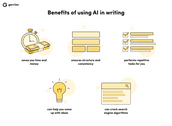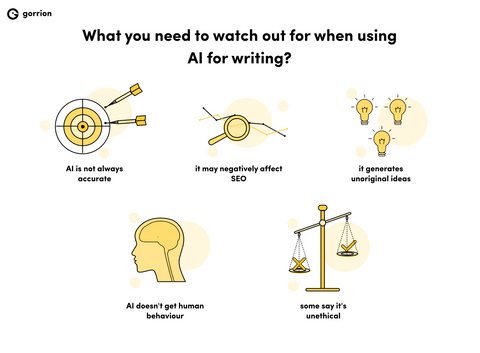


Will artificial intelligence replace writers at your company?
If you’re wondering why your LinkedIn feed is drowning in AI-related content these days, this article provides an explanation why it has become such a hot topic. It also offers some suggestions how your company could use AI to create marketing copy, documentation, and even user interfaces! Does this mean it’s time to let go of your writers?
A decade ago, when I majored in translation studies, everyone was prophesising the end of the translator. Google Translate was free, computer assisted translation (CAT) tools were getting better by the day, natural language processing (NLP) was the future to research, not plain old translation studies. Here we are in 2023, still laughing about the silly translations computers generate, my friends who practice in the field never go on holidays because they’re so swamped with their job, and the world is somehow to this day crying out that the death of the translator is coming.
So, you can imagine that it’s hard for me not to see the irony when ten years later I find myself in a content marketing role and hear about the death of the copywriter. AI writing software has been steadily gaining traction over the last few years. But in the past months, the internet exploded when ChatGPT was released and, for the first time, an advanced language processing model that can generate human-like content became (temporarily) free and widely available for anyone to try.
You can also understand why I’m still not particularly afraid for either my or any other writer’s job, and don’t consider ChatGPT (or any other AI writing software tools) my “competition.” But, objectively – if not entirely, then to what extent can AI replace real writers? And to what extent can it simplify or ease their work? Let’s find out!
How does AI writing work?
If AI writing is a little bit of black box magic for you, let me first explain how it works. To put it simply, you provide the content generator with a prompt (such as “write a 1500-word-long-article about AI writing”). Obviously, the more specific and detailed the prompt, the more accurate the results. (For example: “write a 1500-word-long article about AI writing, focusing on its implementation in copywriting, UX writing, and technical writing, listing benefits, drawbacks, and the most popular applications.”)
Naturally, you may ask yourself: how does the tool know all the answers? Well, to be honest, I can’t really help you with the technical aspects. (But I can hook you up with some of my more software-oriented colleagues at Gorrion who can explain!) In layman terms, though, there is an algorithm that was trained to generate relevant, context-based content from the data it was fed.


Have a project in mind?
Let’s meet - book a free consultation and we’ll get back to you within 24 hrs.
The “feeding” part is important here, because it means that the software doesn’t “know” anything of its own. It can only synthesise the information it was fed. This is why in the conversations about AI-generated content you can often hear about “content scraping.” It’s a form of data mining, where content from the web is being automatically retrieved and analysed by the algorithm. In other words, the content that you get back is based on whatever already exists on the internet. We’ll discuss the implications of that later.
Where can you use AI writing?
There are several ways in which your company can use AI to either generate content or assist your writers in creating it.
Obviously, you can use artificial intelligence to create marketing content, be it articles, product descriptions, e-mail campaigns, or even social media copy. There are plenty of tools for that on the market, such as copy.ai or Anyword.
However, you’ll also find tools that assist copywriters, rather than replace them. For example, Wordtune and QuillBot are handy tools that can paraphrase sentences to make them sound better. There’s very popular Grammarly that not only checks the text for grammatical errors, but also uses AI to suggest improvements. And then there are content optimization tools that content and SEO specialists alike can’t imagine their lives without, like SurferSEO. These analyse competing content on the web to tell you how to optimize your text to rank better in search.
Whatever content writers can use, so can technical writers to make their jobs easier. Platforms like Writer can help them improve the consistency and readability of their writing. Both are critical when it comes to technical content.
But AI also paves new avenues for employing developers as technical writers. For years companies have struggled with the Catch-22 of developers who don’t have time and, largely, writing skills to write documentation, and writers who don’t have in-depth knowledge. Now, developers who need to create documentation can use AI to structure their highly technical prompts into something more user-friendly.
The benefits of using AI in writing
As you can imagine already, there are plenty of reasons why your company would get interested in using AI to generate content. Here are some of them.
It saves time…
From my own experience I can tell you that writing an article takes anywhere from a day to a week (or more!), depending on how long it should be and how hard the topic is. As for AI writing software? It can scan and synthesise tons of content and then spew out the results in a matter of seconds. Even if you take into account the time that it takes to proofread the article or adjust the style, you’re still saving a lot of manhours.
…especially on repetitive tasks
Say, you’re setting up an ecommerce platform and looking at generating thousands of product descriptions. If so, then:
a. I don’t envy the copywriter who has to create them;
b. it makes sense to automatise the process as much as possible.
In instances like that an AI writing tool can literally save you hundreds of hours and thousands of pounds. And copywriters will actually be thankful that they don’t have to do it themselves.
And then there are technical and UX writers who could benefit from the automatization of such tasks even more. There’s no denying that the consistency required from them sometimes leads to repetitiveness that us humans find inherently boring. So, if an interface prompt or some other instructions appear in multiple contexts, tools can easily pick up on that and autofill the content, saving the writers some work.
It gets creative juices flowing
While not all writers are on board with the idea of generating entire content using AI writing tools, there is something that unites them all. It’s the fear of the blank page that strikes every now and then. AI writing tools can be a helpful companion to doing quick research and synthesising ideas that become the starting point of a great article.
And it never gets tired
I always say that the shorter the copy, the more difficult it is to create. And while I know I should come up with ten alternative titles for my blog post and my email subject line, and pick the best… The reality is, I can rarely do more than five. An algorithm, though? When I asked an AI writing tool about alternative titles for this article, it stopped at 47. Granted, not all of them were usable, but then again – neither were all mine!
It knows better
Even if your marketing team isn’t using AI-generated content, they can still benefit from AI writing assistants, like the ones I mentioned before. After all, to a large extent the success of your online content is determined by search engine algorithms. You as a person won’t crack the algorithm for sure, but another algorithm can, so why not take advantage of that?
It ensures structure and consistency
As I wrote before, AI can help technical and UX writers create more structured and consistent copy. And I’m sure you’ll agree these two factors are critical in their professions. You don’t want your users to be confused when they find the same button described in two different terms in two different places. Or when one manual has A-B-C structure, but another one has B-D-C structure instead.
AI-assisted virtual style and terminology guides can guard the stylistic and lexical consistency of your technical content, regardless of how many writers you have on the team or how many documents or prompts they create.
It never stops learning
Last but definitely not least, I should mention perhaps the biggest benefit that AI can bring to UX writing and that is its ability to generate dynamic, activity-based help.
If you’re a gamer, you might remember a situation where a game offered you a helpful reminder of some button combination when you were stuck in one place and didn’t know how to progress, right? That was the algorithm picking up on context clues that you need help.
What’s now commonly used in games can be a huge help for software users as well. Programs that “sense” you don’t know how to use them and guide you when you need it, are the future that’s only possible with AI.
The drawbacks of using AI in writing
Obviously, using AI writing tools is not all puppies and rainbows. If it were, we’d all be doing it already and this text would be automatically generated as well. So why isn’t it?
Unclear effects on SEO
Just like using an AI writing assistant to optimize your text may improve your search engine rankings, using it to create your text may send your performance down the drain. While the supporting data is largely anecdotal at this point, it seems that the latest Google search update (the Helpful Content Update) was aimed directly at artificially generated content. And then there are quite unambiguous statements made by Google as to how it feels about it. So if SEO plays a role in your marketing efforts, it’s best to monitor the situation closely and adjust accordingly.
AI software sometimes lies
Not that the lying is intentional, but there are plenty of examples on the internet where the software… missed the mark on veracity, so to say. AI writing software can’t distinguish between facts and fiction, so the output may not be 100% factual. This is why you should always be sceptical of AI-generated content and proof-read it before publishing.
AI doesn’t have emotions
While the AI writing tools are getting increasingly smarter, they’re still a long way from sounding human. Yes, they often allow you to adjust the style to be more or less formal and you can even ask the AI content generator to write something in, let’s say, Dickensian style. But you cannot expect it to imitate your distinctive brand voice. In fact, you can’t even expect it to always sound 100% natural, which is another reason why you should always proofread it.
…opinions, or ideas
Another thing your company should have is its own take on things. Again, this is something that AI writing software is incapable of. As I explained before, AI can only harvest and mash up existing ideas, not generate them or evaluate them. If originality is important for your business, you should then ask yourself: what are you bringing to the table with artificially generated content and why should anyone care if it’s purely imitative?
…nor the understanding of human behaviour
When it comes to UX and technical writing, the lack of a “human touch” creates another problem. AI doesn’t really understand how people think or that they don’t always think logically. If you ask an AI writing tool to provide some instructions, you’ll often notice it might miss key stages needed for resolution, or brush over things you know will be problematic for the users. This is why it’s so important for technical content to be reviewed by people who have… well, a human perspective.
You could argue it’s unethical
The fact that an AI writer needs to be first fed information that it effectively reuses raises some questions whether this practice is actually ethical. Even if the data used comes from publicly available sources (i.e. the internet), content creators still have the right to their intellectual property and they likely published the content with the intention to be consumed, not repurposed by others. If the source material is used without consent and the output offers nothing original, you can see why some would ask if that’s fair game.
So, is AI writing a go?
For me, personally, dropping your human writers and turning to an AI writer is a bad move. There’s just too much to lose, considering all the disadvantages I discussed. It will benefit neither your marketing, nor technical writing, and the temporary financial gains will turn to losses in no time. Especially since ChatGPT won’t be free forever – remember that it’s only available for free now so that the company can get more data and train its models better. And all other tools you need to pay for.
Having said that, I do believe all of these tools have their place and are worth their buck, but only when they are used to assist writers, not replace them. Yes, they can be a great help for churning out ideas, proofreading, providing structure, and more. But they just cannot replace good writing.
So is the death of the writer coming? I don’t think so. I think they’ll be riding the same boat as translators for a while still.


Have a project in mind?
Let’s meet - book a free consultation and we’ll get back to you within 24 hrs.
At Gorrion, Dominika Stankiewicz manages content. Having spent a decade in marketing and communications, she’s the master of the written word and the guardian of style. On our blog she shares her experience in B2B product marketing to help SaaS companies plan and execute their go-to-market strategy. In her spare time, she reviews manuscripts for publishers and bakes cakes. She loves cats, books, and American football.




